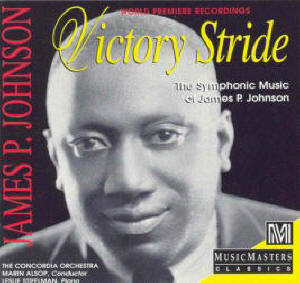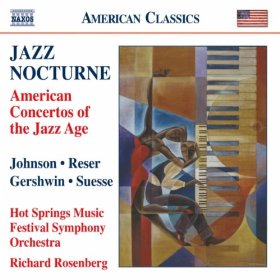Home
Blog
Composers
Musicians
Black History
Audio
About Us
Links
Composers:
Adams, H. Leslie
Akpabot, Samuel Ekpe
Alberga, Eleanor
Bonds, Margaret Allison
Brouwer, Leo
Burleigh, Henry Thacker
Coleridge-Taylor, Samuel
Cunningham, Arthur
Dawson, William Levi
Dede, Edmund
Dett, R. Nathaniel
Elie, Justin
Ellington, Edward K. "Duke"
Euba, Akin
Garcia, José Mauricio Nunes
Hailstork, Adolphus C.
Holland, Justin
Jeanty, Occide
Johnson, James Price
Joplin, Scott
Kay, Ulysses Simpson
Khumalo, Mzilikazi
Lambert, Charles Lucien, Sr.
Lambert, Lucien-Leon G., Jr.
Lamothe, Ludovic
Leon, Tania
Moerane, Michael Mosoeu
Perkinson, Coleridge-Taylor
Pradel, Alain Pierre
Price, Florence Beatrice Smith
Racine, Julio
Roldan, Amadeo
Saint-Georges, Le Chevalier de
Sancho, Ignatius
Smith, Hale
Smith, Irene Britton
Sowande, Fela
Still, William Grant
Walker, George Theophilus
White, José Silvestre
Williams. Julius Penson
AfriClassical Blog
Companion to AfriClassical.com
Guest Book
William J. Zick, Webmaster,
wzick@ameritech.net
©
Copyright 2006 - 2022
William J. Zick
All rights reserved for all content of AfriClassical.com
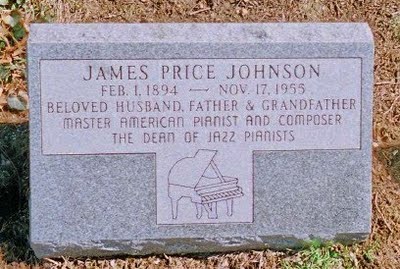
James Price Johnson
Grave Marker
Financed by 2009 "Rent Party"
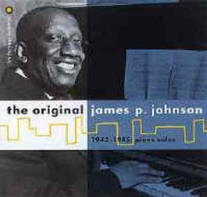
The Original James P. Johnson
Smithsonian Folkways 40812 (1996)
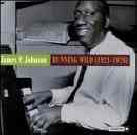
Runnin' Wild (1921-1926)
Tradition Records 1048 (1997)

Carolina Shout
James P. Johnson, piano
(Piano roll transfers)
Biograph 105 (1993)
|
Home ->
Composers -> Johnson, James Price
Français
Jazz Nocturne: American
Concertos of the Jazz Age; Johnson, Reser, Gershwin, Suesse;
Hot Springs Music Festival Symphony Orchestra; Richard
Rosenberg; Naxos 8.559647 (2011)
[James P. Johnson's Yamekraw: A Negro Rhapsody, orchestrated
by William Grant Still, is the opening work on the CD, which
is the world premiere recording of the final version of the
work]
Audio Sample:
Clarion CLR907CD (2004); Got the Saint Louis Blues: Classical Music in the Jazz
Age; VocalEssence Ensemble; Philip Brunelle, Conductor
Yamekraw: A Negro Rhapsody
1 Birth
The
African American composer and pianist James Price Johnson was
born on Feb. 1, 1894 in New Brunswick, New Jersey. His biography
is James P. Johnson:
A Case of Mistaken Identity
by Scott
E. Brown. Brown also wrote the liner notes for the CD
Victory Stride: The Symphonic
Music of James P. Johnson,
Music Masters 67140 (1994). Pianist Leslie Stifelman and The
Concordia Orchestra are led by Marin Alsop, conductor. Dr.
Dominique-René de Lerma of Lawrence University in Appleton,
Wisconsin has specialized in Black composers for four decades,
and has made his research available to this website. Regarding
Johnson's father, Scott E. Brown writes:
|
The original record of
birth in the Bureau of Statistics in New Brunswick
spells out the name William H. Johnson and that of James
P.'s mother Josephine Harrison. |
2 Youth
Johnson's biographer tells us that the family's relocation
to Jersey City led James to decide he wanted to become a “tickler”:
|
In
1902, when Johnson was eight, the family moved to Jersey
City.
***
The entertainment inside the saloons was usually
supplied by an individual known as a “tickler,” and it
was a tickler that James P. Johnson knew he wanted to
become. A tickler was a ragtime piano player, so named
for his manner of handling not only the ivories but
women as well. |
3 Symphony Concerts
In spite of his
family's working class status, Brown writes, young James began
attending symphony concerts in New York:
|
In
1905, when Johnson was eleven, he began to attend New
York symphony concerts. A friend of one of his older
brothers worked as a waiter, and was able to get tickets
from Josef Stransky, the Symphony's conductor. It was
his first exposure to the old masters. “I didn't get
much out of them,” said Johnson, “but the full symphonic
sounds made a great impression on me.” They obviously
struck some internal sensitivity, as he later utilized
the forms of Western art music to compose his own
rhapsodies, symphonies, and concertos based on
Afro-American musical themes. |
4 Pianist
A summer job in 1912 proved so
profitable that James took a job in a cabaret instead of
returning to school in the autumn, Scott Brown relates:
|
During the summer of
1912, Johnson made his way out to Far Rockaway, a beach
resort near Coney Island.
***
"It was a rough place, but I got nine dollars and tips,
or about eighteen dollars a week over all. That was so
much money that I didn't want to go back to school."
***
The author quotes Johnson: “That fall, instead of going
back to school, I went to Jersey City and got a job in a
cabaret run by Freddie Doyle." |
5 Music Lessons
The biographer writes that
Johnson began music lessons with Bruto Giannini:
|
Johnson soon undertook
his first formal musical training. He had become
friendly with Ernest Green, a cabaret tickler who was
also very proficient in the popular classical repertory.
Johnson recalled his virtuoso renditions of the “William
Tell” and “Light Cavalry” Overtures. Green's mother
encouraged Johnson to study formally with an Italian
music teacher named Bruto Giannini. “Ernest's mother got
opera lessons from old professor Giannini by doing his
housework. And she got him to teach me my harmony and
counterpoint for just a dollar a lesson. He taught me
for four years. I had to throw away my fingering and
learn to put the right finger on the right note. I was
on Bach, and double thirds need good fingering.” |
6 Chronology
Scott Brown discusses a
controversy over the chronology of Johnson's lessons with Bruto
Giannini:
|
Although some sources
indicate that Johnson studied with Giannini while still
in Jersey City, there is evidence to the contrary. In
his conversation with Tom Davin, Johnson implies that he
started with Giannini in 1913; 1914 is given by Charles
Edward Smith in his liner notes to Johnson's “New York
Jazz” album. Johnson also refers to Ernest Green as “a
new friend of mine” after he had moved to New York. It
is therefore more likely that Johnson's training with
Giannini began sometime around 1913 and lasted to 1916
or 1917. The time sequence is important, as it appears
that Johnson began serious study not as a child of eight
or nine, but after playing many professional engagements
and building groundwork for his own style. |
7 Newark
The biography of
Johnson reports that the pianist went to Newark in 1914:
|
After a
brief return to New York, Johnson went to Newark, New
Jersey in the fall of 1914. There he met Willie “The
Lion” Smith, a first-class tickler who came to be one of
Johnson's closest friends. Smith was playing in a place
called Randolph's, located in the tough section of
Newark known as the Coast. Johnson was traveling with a
singer-dancer named Lillie Mae Wright, who later became
Mrs. James P. Johnson. |
8 Stride Piano
In his liner notes for
Victory Stride,
Scott E. Brown points out that James P. Johnson was called the
Father of Stride Piano:
|
James P. Johnson was
an astounding musician, arguably the most important
black musician in New York during the decade of the
1920s. He is best known in jazz as the Father of Stride
Piano, a two-handed, solo piano style that developed out
of ragtime and flourished in the Northeast, especially
Harlem, during the 1920s as the first true jazz idiom.
He has influenced many successive jazz musicians,
including his students Fats Waller and Duke Ellington. |
9 Carolina Shout
Brown's
liner notes emphasize the importance of James P. Johnson's
Carolina Shout:
|
”Carolina Shout” is considered by many to be the first
recorded jazz piano solo (1921). Johnson was the first
black staff musician for the QRS piano roll company and
favorite accompanist of Bessie Smith and Ethel Waters. |
10 Charleston
Composing
for musicals was a major part of Johnson's career as well, the
Victory Stride
liner notes explain:
|
As
a composer, he scored all or part of at least 16 musical
revues during the 1920s. Out of his 1923 Broadway
production
Runnin' Wild
came the tune and dance most closely associated with the
entire decade, the “Charleston.” |
11 Music Studies
Prof. Dominique-René de Lerma
wrote the liner notes for the CD
Got the Saint-Louis Blues:
Classical Music in the Jazz Age,
Clarion CLR907 (2004), which includes a performance of Johnson's
Yamekraw: A Negro
Rhapsody (15:49) by
pianist Paul Shaw and the VocalEssence Ensemble conducted by
Philip Brunelle. Dr. De Lerma relates that Johnson's music
studies with Bruto Giannini were followed by piano lessons from
Eubie Blake. He continues:
|
Toward the end of the
1920s, Johnson began devoting time to the study of
orchestration, counterpoint, and harmony. |
12 Serious Composer
In his liner notes, Scott
Brown agrees that Johnson was intent on becoming a serious
composer:
|
Of all
his accomplishments, James P. Johnson most wanted to be
remembered as a serious composer of symphonic music
utilizing African-American musical themes. When the
Depression ended the decade of the Charleston, James P.
Johnson semi-retired from active Harlem nightlife to
concentrate on symphonic composition.
***
Despite little recognition and limited encouragement,
James P Johnson would write two symphonies, a piano and
a clarinet concerto, two ballets, two one-act operas and
a number of sonatas, suites, tone poems and a string
quartet. |
13 Yamekraw
The biographer writes
that Yamekraw: A Negro Rhapsody
was the first work to bring
to life Johnson's dream of being a serious composer:
|
The foreword to
“Yamekraw” describes the intent of the work as “A
genuine Negro treatise on spiritual, syncopated and 'blue'
melodies by James P. Johnson, expressing the religious
fervor and happy moods of the natives of Yamekraw, a
Negro settlement situated on the outskirts of Savannah,
Georgia.
***
“Yamekraw”
was the first realization of Johnson's desire to be
considered a serious composer. |
14 Orchestration
Prof. De Lerma explains that
Yamekraw
was written to celebrate an African American community in
Georgia. He also provides details of the work's orchestration
and premiere:
|
Written in celebration
of a black community on the outskirts of Savannah,
Yamekraw: A
Negro Rhapsody
(1927) was first performed by Fats Waller in a Carnegie
Hall concert organized by William C. Handy. It seems
most likely that Johnson's relative inexperience in
orchestral writing prompted him to ask William Grant
Still to rework the score in 1928. Still's version calls
for three saxophones, two trumpets and trombone joined
by banjo, drums and strings. The solo piano part amply
illustrates Johnson's wide reach, with an abundance of
stride piano left-hand tenths and extended right-hand
excursions, all the while infused with the blues. |
15 Final Version
Richard Rosenberg
conducts the Hot Springs Music Festival Symphony Orchestra in
James P. Johnson's Yamekraw: A Negro Rhapsody, orchestrated
by William Grant Still, the opening work on the CD
Jazz Nocturne - American
Concertos of the Jazz Age; Naxos 8.559647 (2011). He
writes of the Carnegie Hall concert in the liner notes:
|
Unfortunately,
Johnson was not released from his duties as conductor of
the musical Keep Shufflin’ that evening, so his
protégé Thomas “Fats” Waller played the piano solo part
at the concert. The piece was quite successful—it was
used as the soundtrack of a 1930 Vitaphone motion
picture short subject also entitled Yamekraw, and
as the overture to Orson Welles’ production of “Macbeth”
later in the 1930s, and was recorded in abbreviated
versions several times.
...
This disc marks the première recording of the complete, final orchestral
version of the work. |
16 Solo Piano
A solo piano version
of Yamekraw: A Negro Rhapsody (14:12) has been recorded
by pianist Marco Fumo on Rhapsody in Black and White,
Dynamic 351 (2000). He teaches piano at the Conservatory of
Castel Franco Veneto in Italy and is a specialist in the
performance of African American piano repertoire of the jazz
age. He writes in the liner notes:
|
Most of his output is
known only to the lovers of jazz, while some of his
symphonic and theatrical works appear to have been lost.
His rhapsody Yamekraw (1927) was his first
large-scale work, a sort of answer to the Rhapsody in
Blue: it is a portrait of the world of the black
people made from the inside. Like Joplin, Johnson
describes a group of country people from the South, re-evoking
in rapid sequence their moments of feast, of prayer, of
labour. |
Fumo says the
composer recorded the piano version in the 1940s for Folkways.
17 Fellowship
The biography
relates an effort by Johnson to obtain a Guggenheim Fellowship:
|
Sometime in the mid-1930s,
Johnson contacted James Weldon Johnson, asking for his
help in obtaining a Guggenheim Fellowship. James P.
expressed his strong desire to continue his musical
education and to keep working on new compositions, an
endeavor which required financial support. No records
indicate he was successful in obtaining a grant, but he
pursued his music nonetheless. |
18
The Organizer
Scott Brown lists some
additional serious compositions of Johnson, including the 1934
work
Concerto Jazz A Mine:
|
In 1932, Johnson
completed his “Harlem Symphony.”
***
A second symphony, “Symphony in Brown,” was copyrighted
in 1935 by Johnson himself (as was “Jassamine”) and
never published. A number of other serious pieces have
been attributed to Johnson, but no trace of them has
been found. There is one other work, however, which is
of musical, cultural, and historical interest. James P.
Johnson collaborated with the famous poet Langston
Hughes to create
The Organizer
– A Blues Opera in One Act.
***
The
Organizer
was performed at Carnegie Hall in 1940 as part of an
International Ladies' Garment Workers Union convention.
|
19 Strokes
Dr. Dominique-René
de Lerma writes of two of the strokes Johnson suffered:
|
His first stroke in 1940
did not prevent him from presenting a concert of his own
works at Carnegie Hall in 1944, but a much more serious
stroke occurred in 1951, confining him to bed until his
death. |
20 Death
James Price Johnson
died on Nov. 17, 1955, we are told by Scott E. Brown:
|
James P. Johnson died as a
result of a final massive stroke. He was admitted to
Queens General Hospital after having suffered the stroke
(his eighth) at home two days earlier. All the major
newspapers carried his obituary, but his name probably
meant little to the general public. One thing,
however, is very interesting about these obituaries.
In their headlines and opening paragraphs, they identify
Johnson not only as a jazz pianist but also as a
prolific composer. |
21 More CDs
Dozens more CDs of the music of James P. Johnson are available
at music stores and at Web sites such as
www.amazon.com and
www.arkivmusic.com Examples are:
Harlem Stride Piano 1921-1929, Epm Musique 158952 (1997) and
Runnin' Wild (1921-1926),
Tradition Records 1048 (1997).
22 Resources
JamesPJohnson.org
www.jamespjohnson.org Biography and
resources, including Talents of James P. Johnson Went
Unappreciated, an obituary by John Hammond in Down Beat
Magazine, December 28, 1955.
RedHotJazz.com/jpjohnson.html
www.redhotjazz.com/jpjohnson.html
Solo discography with ram audio
files. Membership rosters and discography of James P. Johnson's
bands and recording sessions.
Wikipedia.org
http://en.wikipedia.org/wiki/James_P._Johnson Entry on James P. Johnson, with links to related
articles in Wikipedia, The Free Encyclopedia.
This page was last updated
on
March 5, 2022
|





